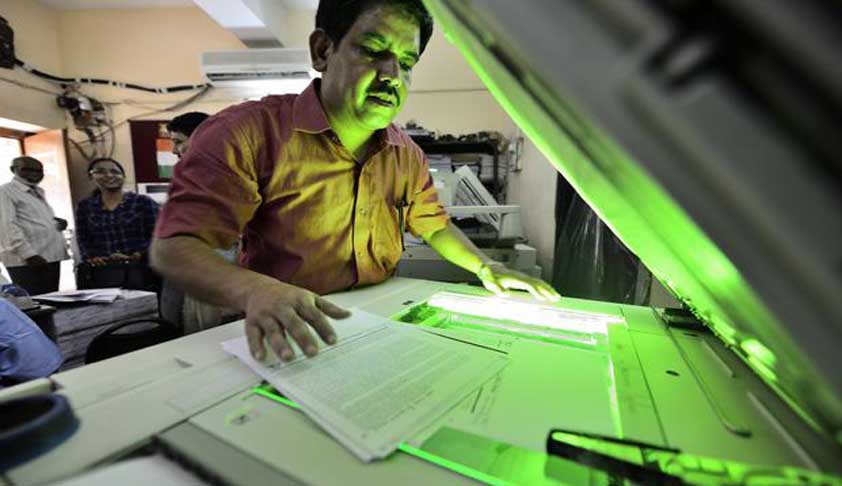Delhi University Photocopy Shop Judgement: A Landmark In The Access To Knowledge Movement In India
Dr Arul George Scaria
24 Sep 2016 8:10 AM GMT
The litigation initiated by some of the major publishers like Oxford University Press and Cambridge University Press against University of Delhi and a small scale photocopy service operating within the premises of Delhi School of Economics (University of Delhi) has been one of the most keenly watched litigations in the area of copyright law. The photocopy service in question has been selling...
The litigation initiated by some of the major publishers like Oxford University Press and Cambridge University Press against University of Delhi and a small scale photocopy service operating within the premises of Delhi School of Economics (University of Delhi) has been one of the most keenly watched litigations in the area of copyright law. The photocopy service in question has been selling to students course packs based on syllabi prescribed by the University. Some of those course packs had extracts from books published by the publishers who initiated the litigation. According to the publishers, apart from providing space on campus for the photocopy service, University libraries were also issuing books to the photocopy service for preparing those course packs. The litigation was initiated by the publishers before the Delhi High Court in the year 2012, alleging violation of rights under copyright law.
The judgment delivered by Justice Rajiv Sahai Endlaw on September 16, 2016 has ruled in favour of the University and the photocopy service, clarifying that there was no copyright infringement in the activities questioned by the publishers. This judgment can undoubtedly be considered as a landmark in the access to knowledge movement, for three reasons – first, the manner in which the Court has attempted to strike a balance within the copyright system; second, the manner in which the Court has interpreted the specific educational use exception provided under the Copyright Act; and finally, the reaffirmation that copyright is not a natural right.
Striking a balance within the copyright system
The most refreshing aspect of this judgment is the way the Court has emphasised that copyright system is not just about copyright holders’ rights, but also users’ rights. The Court achieves this vital balance by highlighting that the rights of potential beneficiaries of the exception provisions under copyright law need to be interpreted using the same rules used for interpreting the rights of copyright owners. In other words, both the exceptions to infringement provided under copyright law and the scope of rights conferred on copyright holders need to be treated equally to strike a balance between the interests of copyright owners and the broader public interest in getting access to copyrighted works. This assumes significance for two important reasons. First, this approach may change the way India approaches the exceptions provided under copyright law. Considering the socio-economic conditions prevalent in the country, the Indian Parliament has provided a long list of enumerated exceptions, along with the broad fair dealing exception. The judgment in this case may also prompt other courts to treat all the provided exceptions with more importance and convert their passive existence in law to more meaningful engagements. Second, this judgment is coming at a time when we see many policies, treaties and judgments that over-focus on the rights of IP holders. India’s new national IP policy, the recent judgment of the Court of Justice for the European Union in the G S Media case (which has made hyperlinking a violation of copyright law under certain circumstances), and the Trans-Pacific Partnership Agreement (which is yet another trade treaty providing TRIPS+ provisions) are just three examples in this regard. The world needs more balanced approaches in the area of intellectual property and this judgment may persuade even other jurisdictions to intervene more strongly for such balanced approaches.
Interpretation of the educational use exception
As mentioned earlier, the second important aspect of the judgment is the way it clarified the scope of Sec. 52(1)(i), which is a specific educational use exception. In this regard, it needs to be noted that the Court avoided the common pitfall of conflating the exceptions provided under the fair dealing provision (Sec. 52(1)(a)) and the other enumerated exceptions under the Indian copyright Act. The Judge rightly considered Sec. 52(1)(i) as the most appropriate provision for the facts of the case and if the judge had taken the fair dealing approach, the result might have been different, as the scope of the provisions are considerably different.
According to Sec. 52(1)(i), the reproduction of any work i) by a teacher or a pupil in the course of instruction; or ii) as part of the questions to be answered in an exam; or ii) in answers to such questions, shall not constitute an infringement of copyright. Since there are no quantity related restrictions specifically mentioned under Sec. 52(1)(i), the core question before the Court was whether the act of reproduction of certain parts of the copyrighted works of the plaintiffs by the University falls within the ambit of “in the course of instruction”. By relying on extensive case laws with regard to basic principles of interpretation of statutes, the Court can be seen reaching the conclusion that reproduction of any copyrighted work by a teacher for the purpose of imparting instruction as prescribed in the syllabus during the academic year would be within the ambit of the exception provided under Sec. 52(1)(i) of the Copyright Act. For reaching this conclusion, the Court gave due consideration to the fact that stocking or issuing multiple copies of the same title to different students is practically impossible and preparing a master photocopy of relevant extracts of books prescribed in the syllabi, making copies based on that master copy and distributing those copies to students cannot constitute infringement of copyright in those books.
It is also interesting to see how the Court addressed the question of whether allowing a photocopy service to install photocopiers within the premises of the University and making copies of the master copy for the purpose of selling to students can constitute infringement. According to the Court, it was immaterial whether a photocopying machine is installed within the library or outside the library. The Court also considered it immaterial whether the University purchased a photocopy machine, allowed students to make copies themselves or employed people to make the photocopies for students. It was of the view that once an action is declared to not be an infringement of copyright, the fact that the act in question is done not by the person directly, but with the assistance of another person, would not make the act infringing. Therefore, in the eyes of the Court, the fact that the University was using the services of a contractor for providing course packs was irrelevant.
In its analysis, due importance was also given to the fact that only extracts from books were used for preparation of the course packs and the books were not copied entirely. According to the Court, this showed that they were not a competitor for the publisher. Similar to the observations of the Supreme Court of Canada in Alberta (Education) case, the Delhi High Court can also be seen making the very important observation that we cannot expect the students to buy all the books only for reading the extracts mentioned in the syllabi. So the students cannot be considered as potential customers of those books and there is hardly any sales displacement happening through use of course packs. This clearly answers the argument that course packs can be detrimental for the existence of publishing industry and that this might affect the incentives of publishers for investments in areas like social sciences. This could also be the reason why no publisher has produced any credible data so far, regarding sales displacements by virtue of course packs.
Another interesting point is the way the Court looked at the potential alternative for course packs - preparing notes by working in a library for long hours. The Court noted that when modern technologies are available, it would be unfair to demand that the studentsshould“continue to study as in ancient era.” The Court can also be seen making the very dynamic observation that “[n]o law can be interpreted so as to result in any regression of the evolvement of the human being for the better.” The Court is clearly of the view that just because 100 or 1000 photocopies are being made, instead of 10 or 20 copies being made by students directly or by a librarian employed by the University, an act which is not otherwise an infringement cannot be turned into an act of infringement.
While some scholars have alleged that giving broad exceptions may be a violation of the three-step tests provided under the Berne Convention and the TRIPS Agreement, the Court has addressed this issue in a rational manner in the judgment. As per the Court, the Constitution and the international covenants empower the legislature to determine what is justified or reasonable, and the courts cannot impose any limitations on the same. The Court is of the view that the legislators have taken the position that the reproduction of copyrighted works in the course of instruction is justified and it is not prejudicing the legitimate interests of the authors. The Court considers it inappropriate to restrict or expand what the legislators have considered appropriate. In this regard, it is pertinent to note that many prominent scholars have recommended a liberal interpretation of the three-step test and the Max Planck Declaration is an important document in this regard. The position taken by the Court is in tune with the Max Planck Declaration, which has noted in particular that “[t]he Three-Step Test’s restriction of limitations and exceptions to exclusive rights to certain special cases does not prevent (a) legislatures from introducing open ended limitations and exceptions, so long as the scope of such limitations and exceptions is reasonably foreseeable; or (b) courts from - applying existing statutory limitations and exceptions to similar factual circumstances mutatis mutandis; or - creating further limitations or exceptions, where possible within the legal systems of which they form a part.”
Is copyright a natural right?
Finally, it is refreshing to see a court reaffirming that copyright is not a natural right and all the rights under the copyright regime are creations of the statute. The Court has re-emphasised the important aspect that there cannot be any right, except those specifically granted by the Copyright Act. In the words of the Court, “[c]opyright, specially in literary works, is thus not an inevitable, divine, or natural right that confers on authors the absolute ownership of their creations. It is designed rather to stimulate activity and progress in the arts for the intellectual enrichment of the public. Copyright is intended to increase and not to impede the harvest of knowledge. It is intended to motivate the creative activity of authors and inventors in order to benefit the public.” Not many courts have so beautifully captured this essential dimension of the balance required in intellectual property.
In view of all these factors, the judgment of the Delhi High Court can be described as one of the landmarks in the global access to knowledge movement. It is hoped that this judgment may force policy makers, judges and legislators to take more balanced IP approaches for democratising knowledge.
 Dr Arul George Scaria is an Assistant Professor of law and Co-Director of the Centre for Innovation, Intellectual Property and Competition (CIIPC) at the National Law University, Delhi.Views expressed are personal.
Dr Arul George Scaria is an Assistant Professor of law and Co-Director of the Centre for Innovation, Intellectual Property and Competition (CIIPC) at the National Law University, Delhi.Views expressed are personal.
Image from here.


